New technologies and the companies that develop them have become deeply ingrained in popular culture. Product unveilings make front page news. Technology conferences are attended or live-streamed by thousands of people. Cryptic tweets and quotes from CEOs are dissected for days. Yet despite the intense interest in disruptive technologies, how commonplace are these game changing products in our every day lives?
In May 2019, we partnered with Engine, a leading market research company, to survey 500 consumers about their adoption of new technologies ranging from electric vehicles to FinTech. Click here to download the PDF version, or scroll down to read our blog post.
Technologies Reviewed
Electric Vehicles | Ride-share Apps | E-commerce | Internet of Things | Genomics | Robotics | FinTech
Key Takeaways
- Overall adoption and comfort level with many disruptive technologies remains low across generations. This could be due to consumers waiting for the technology to become more established, for prices to fall, or they are simply entrenched in their current habits.
- Despite low current adoption, consumer interest in new technologies is high, indicating that these products are likely to be considered for future purchases. We believe this indicates strong growth is ahead for many of these products and the companies that make them.
- Among cohorts, the Millennial generation is likely to be the major driver of increased adoption, due to a unique affinity for tech-focused products.
Electric Vehicles
While just 5% of consumers use an electric vehicle on a weekly or more frequent basis, 17% expect to purchase an EV in the next 5 years.
Q: When would you plan to purchase an electric vehicle?

Ride Sharing Apps
While 75% of consumers are users of ride sharing apps, less than 6% use them on a weekly or more frequent basis.
Q: How frequently do you use Ride-Sharing Apps?

E-Commerce
While over 40% of the population is comfortable buying smaller-ticket items online, like clothes, shoes, and cosmetics, less than 15% of the population is comfortable buying big-ticket items like fine jewelry, cars or other vehicles, or a home/apartment.
Q: Which of the following, if any, would you be willing to purchase on the internet without first having seen it in person?
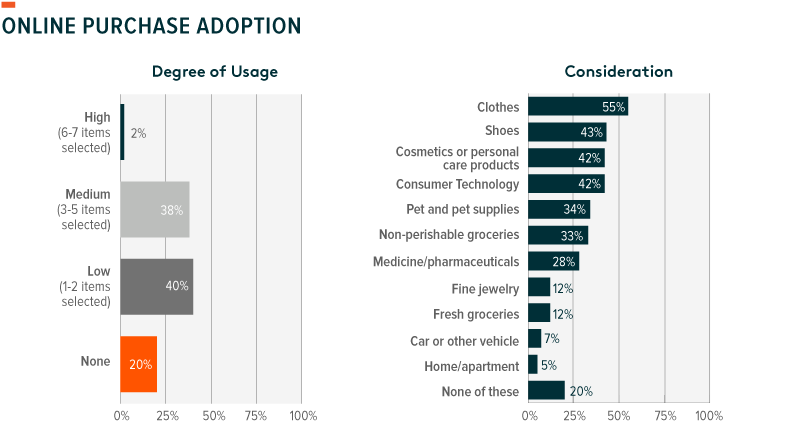
Internet of Things/Smart-Devices
77% of consumers are not using smart-home devices like smart TVs or smart appliances.
Q: Which of the following home appliances, if any, do you operate from a mobile device?
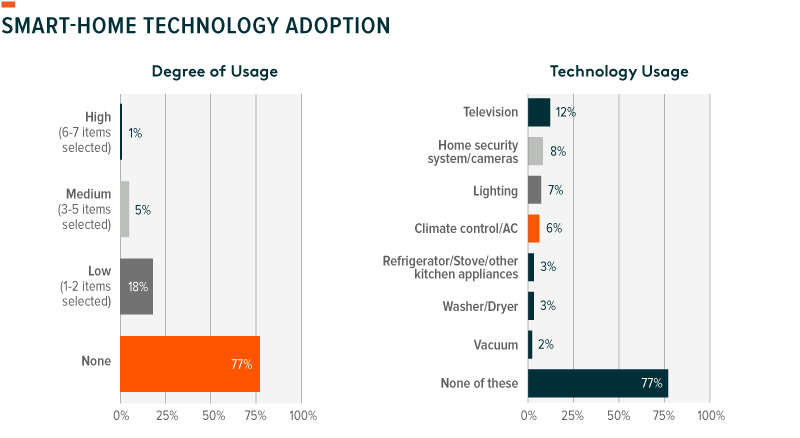
Genomics
Comfort level with using genomics or DNA technology across various use cases remains low.
Q: How comfortable are you with gene sequencing or DNA technology being used for the following?

Robotics
Similarly, comfort level with incorporating robotics into everyday tasks remains low.
Q: How comfortable would you be having a robot complete the following tasks?
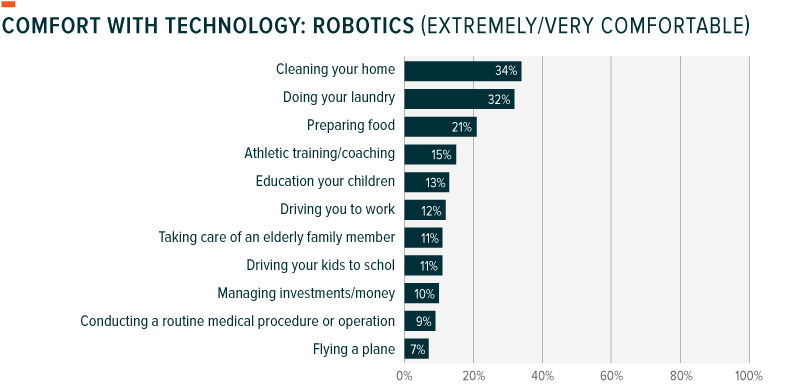
FinTech
Cash isn’t king, credit cards are, with 84% usage on a weekly basis. Comparatively, only 11% of consumers use mobile wallets on a weekly basis, and just 6% use peer-to-peer (P2P) payments at the same frequency, demonstrating low penetration of the latest FinTech payment options.
Q: How often do you pay for something using the following?

Millennials Will Be the Driving Force of Adoption
Much has been made about the different spending patterns of the Millennial generation versus older cohorts, particularly their affinity for technology. These unique preferences are apparent in our survey, as Millennials frequently indicated higher adoption, greater interest, and more comfort in new technologies than the next largest population group in the US, the Baby Boomers.
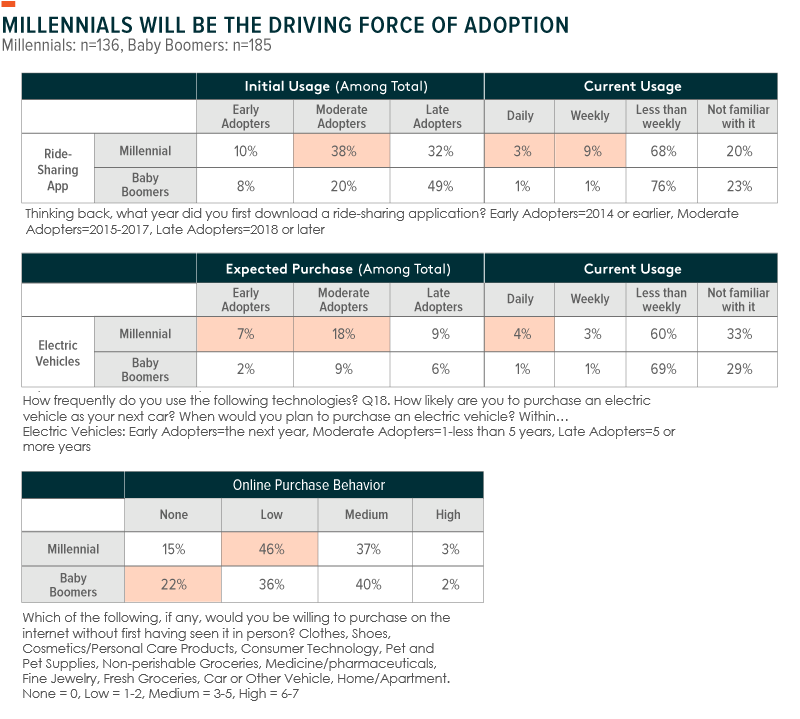
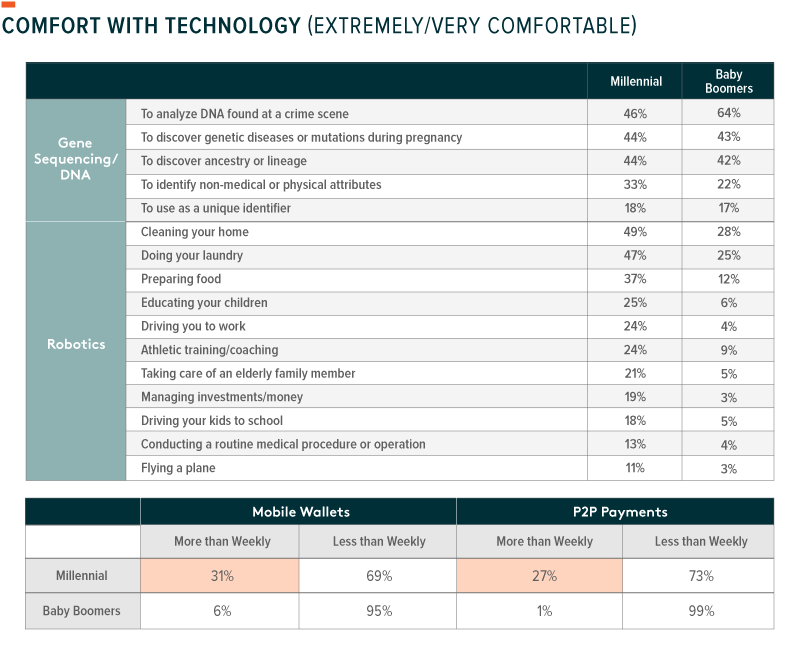
Conclusion
While we frequently discuss new technologies like electric vehicles, smart devices, and FinTech, we are still early in their adoption cycle. Consumers are fickle and habit-forming, making it difficult for new technologies to replace the old guard. Yet despite these challenges, many of these innovations are starting to gain a foothold, driven by the consumption habits of the Millennial generation. As technology continues to progress and Millennial spending power increases, we believe that many of these disruptions will achieve widespread adoption.
 Global X Research Team
Global X Research Team